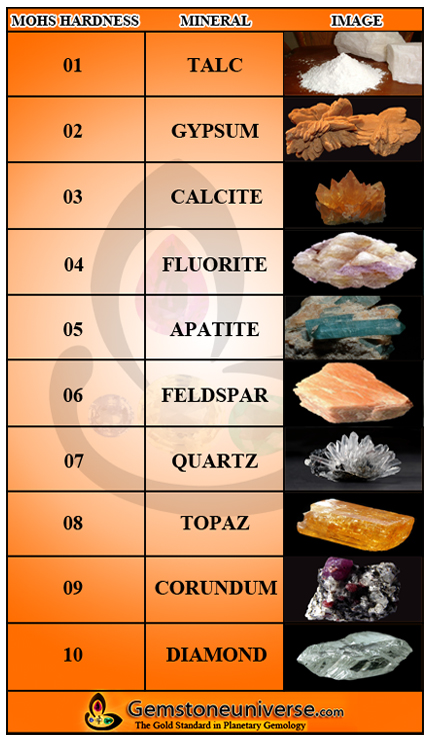
Clicking on Underlined Links will give more information about a topic. You can always come back to this page
What Problems Can Astrology & Jyotish Gemstones Solve? Can they solve My Unique problems
Which is the Best Gemstone Choosing Method | Which Gemstone Should I wear
Do Gems Work- No They Don’t for 90% of the People-Why?.
What results Can I expect from Jyotish Gemstones?
In Quest of India’s Best Gemstone Astrologer.
Tell me My Best Life Changing Gemstone
What is Mohs Scale of Hardness | Mohs Scale of Mineral Hardness of a Gemstone
The three factors that characterise gemstones are beauty, rarity and durability. Gemstones possess value because they are durable-they last a long time. Durability in essence is a combination of hardness, toughness and stability. The above three terms are very distinct when referred to in context of mineralogical criteria.
Hardness is a measure of how easily a gemstone will get scratched or how it is affected by abrasion. Organic red Coral gemstone gets scratched easily and therefore it measures less on the scale of hardness. At the same time diamond resists any kind of scratching and is by itself the hardest substance known. Diamond measures the highest on the Moh’s scale of mineral hardness.
Toughness of the gemstone on the other hand is a measure of how hard or how easily a Gemstone will break, get chipped or crack! Some gemstones may measure high on hardness levels but may not rank greatly where toughness is concerned. These especially are the gems with perfect cleavage that can cleave or split on impact. Gemstones like diamond, tanzanite, topaz, moonstone etc have perfect cleavage.
The factor of stability is all about the gemstone's response to external factors like heat, light and chemicals. Gemstones like rubies and sapphires are relatively quite stable. There are other gemstones which may corrode easily in the presence of chemicals or some others which may lose their moisture content - like opals and emeralds in the presence of strong lights or heat.
What is the Mohs Scale of Mineral Hardness of a Gemstone
The Mohs Scale of hardness also referred to as the Mohs Scale of Mineral Hardness was devised in 1812 by Dr Frederich Mohs who was a Germany mineralogy specialist. He took 10 minerals that were fairly commonly known and ranked them in order of hardness from 1-10. The Mohs scale is not a linear scale and is quite arbitrary. While talc is the softest substance getting a rank of one, diamond is the hardest getting ranked at 10.
It is important to understand that the difference in hardness between subsequent levels is not the same. Diamond (Rank 10) is about 140 times harder than corundum (Rank 9) which again is about 80 times harder than topaz (Rank 8).
These anomalies do not take away the usefulness of Mohs scale in any way. It is still used popularly and is actually favoured in the gemstone industry. It is one of the most reliable parameter for the bench jeweller to determine settings and tools for particular gems.
Please see below the Mohs Scale of Hardness Chart
Mohs Scale of Mineral Hardness Chart.
Clicking on Underlined Links will give more information about a topic. You can always come back to this page
What Problems Can Astrology & Jyotish Gemstones Solve? Can they solve My Unique problems
Which is the Best Gemstone Choosing Method | Which Gemstone Should I wear
Do Gems Work- No They Don’t for 90% of the People-Why?.
What results Can I expect from Jyotish Gemstones?
In Quest of India’s Best Gemstone Astrologer.
Tell me My Best Life Changing Gemstone
© Gemstoneuniverse- All rights reserved

Gemstoneuniverse-The Gold Standard In Planetary Gemology.


